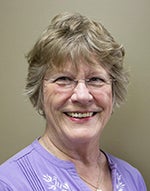Art is: ‘Both Sides of the Bars’ show worth your time
Published 9:00 am Saturday, May 18, 2019
Art is by Bev Jackson Cotter
Bev Jackson Cotter is a member of The Albert Lea Art Center, where the show “On Both Sides of the Bars” will be on display through June 8.
“Nurturing our creative life requires that we open our eyes and our souls and see the beauty around us. We can’t allow the struggles, setbacks and discouragements to shut beauty out of our awareness. The process must be gentle because the song within is shy and retreats in the face of harshness, whether the harshness is that of the larger world or the harshness that we sometimes impose upon our own selves.”

Bev Jackson Cotter
This quote by Roderick MacIver from his book “Art is About the Mystery” reminds me of the vulnerability of creating art and the elusiveness of inspiration. When we dare to put a mark on a piece of paper, then expand on that mark horizontally, vertically, diagonally, straight lines or circular, then show the result to the world, we are displaying our own art, but at the same time saying “This is who I am.” Those lines that we struggle over define not only our skills but our personality and our life history.
That is why I find the current showing at The Albert Lea Art Center so fascinating. “On Both Sides of the Bars” features artwork and creative writing by inmates and detainees from the Freeborn County Detention Center. They participate in weekly classes conducted by Jim Dalton, Carolyn Smith and Carolina Pena, who does Spanish translation when needed.
Many of the paintings in the show are from suggested topics by Jim Dalton, yet in each one there is a different personality. Maybe you can tell by the colors selected by the artist, or the shape of the lines used — rigid and bold or more rounded and shy. Maybe the piece is picture-perfect or maybe abstract. No matter, the artist’s personality comes through.
I particularly like the paintings and writings by a young man originally from Sudan, then by way of Egypt and finally Chicago. His portraits show both history and our current world, and his statement, “My ancestors built the pyramids,” gave me a thrill when I first read it and still does as I write it. His art tells me so much about him and his values.
I wonder how this detention center program will affect the lives of the people involved, the inmates and detainees, the teachers, and the center employees. Beyond taking up some of their time, it must affect their relationships. I wonder, too, if it will affect their futures. Will our community’s support of their efforts make a difference in their attitudes about America or their homes and families?
Am I placing too much emphasis on the value of these classes? I don’t think so.
Heather Coombs, program coordinator at the detention center, said, “Another reason I wanted this program is art is a wonderful stress reliever, it promotes nonviolent communication, provides the satisfaction of creation versus destruction. … There is a lot of healing, expression and peace that comes with writing.”
Carolyn Smith, who helps the inmates and detainees with their writing, mentions how much we can learn by reading about their lives and cultures.
For many years I have attended storytelling or writing events and gatherings, some of them professional and others made up of individuals who share a love of words. I understand these people better than others who I have known for many years. When we write about our lives and share our stories, we are defining who we are, often more than we realize.
In Roderick MacIver’s book he also quotes Graham Greene, who said, “Writing is a form of therapy; sometimes I wonder how all those who do not write, compose or paint can manage to escape the madness, the melancholia, the panic fear which is inherent in the human situation.”
The paintings and writings in “On Both Sides of the Bars” help us to know the inmates and detainees. Not only are they interesting and enjoyable to view, they also help us to know their stories and to begin to understand.

